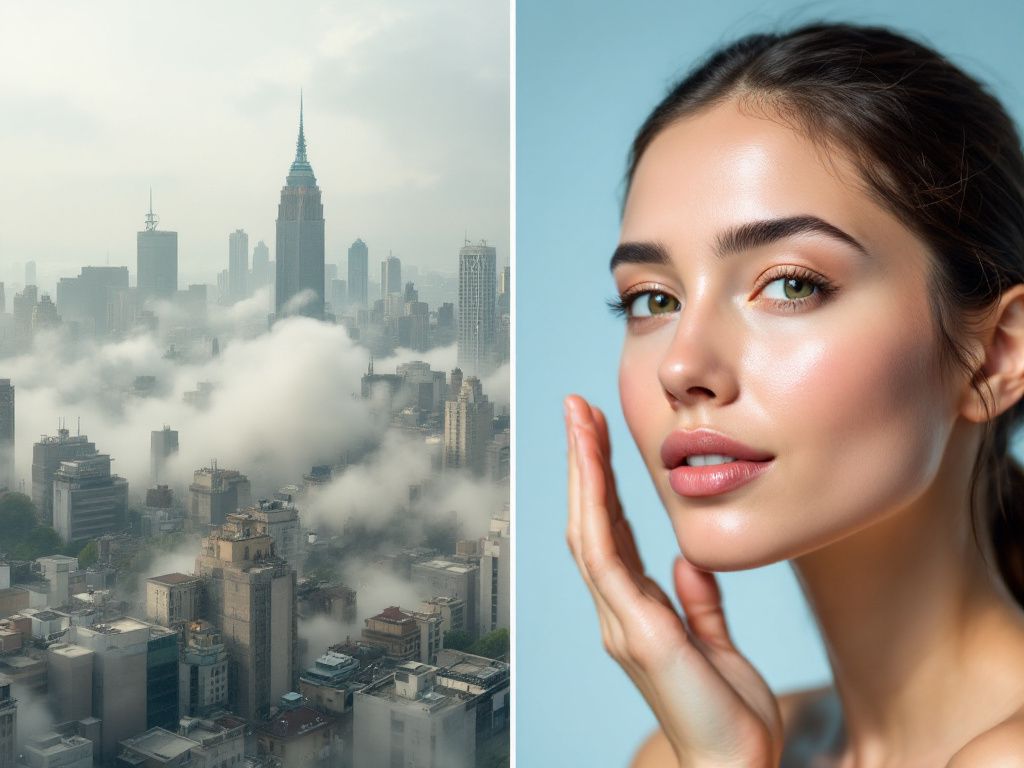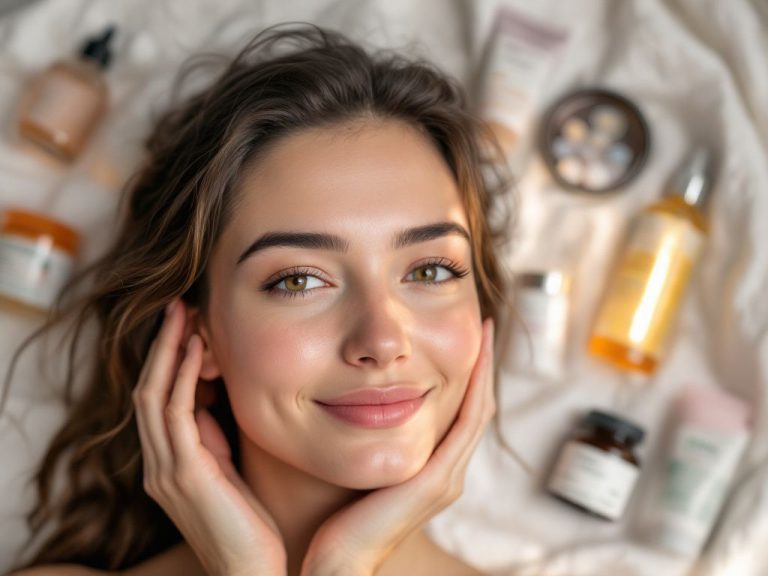Hey there! Let’s talk about something you might not have linked before—air quality and your skin’s ups and downs, particularly the dreaded acne spikes. If breakouts have ever plagued your complexion, especially when you’re in a bustling city or during those smoggy days, it might be time to consider external influences. Yes, the environment, including air quality, can have a considerable impact on skin health. Trust me, understanding this can make a difference in your skincare routine. Stick around as we dive into the unseen world that surrounds us all and how it may secretly whisper chaos into our pores.
Table of Contents
ToggleIs Air Quality Really Sabotaging Your Skin?
We’ve all paid attention to the skincare basics—cleansers, hydration, and of course, SPF. But have you ever stopped to wonder, “Could the air I’m breathing be affecting my skin too?”
Air pollution isn’t just a problem for our lungs. It turns out those tiny particles floating in the air can also clogs pour and trigger inflammation, setting the stage for acne flare-ups. When talking about “air quality impact,” it’s not just an abstract concept. Think of your skin like a sponge—constantly absorbing everything around it. And unfortunately, that sometimes includes pollutants.
How Poor Air Quality Aggravates Acne
- Particulate Matter: These are those microscopic bits of dirt, soot, and droplets in the air. You might not see them, but they’re there. When these particles settle on your skin, they don’t just hang out on the surface. They find those microscopic doorways (your pores) and sneak in, causing blockages and irritation.
- Toxins and Chemicals: Air often carries minuscule toxins, such as polycyclic aromatic hydrocarbons (PAHs) mostly from vehicle exhaust. When they bind to your skin cells, they can cause oxidative stress, disrupting skin barrier function and exacerbating acne issues.
- Low Air Quality Equals More Oil: When the skin traps particles from the environment, it tries to protect itself by producing more oil. Sounds ironic, right? This natural reaction, aimed at skin protection, can actually backfire by leading to more clogged pores and acne breakouts.
The Pollution Effect Cycle

Here’s a quick snapshot: increased pollution ➔ unhealthy skin ➔ more acne
Being aware of these cycles can help you make the environmental connection many overlook. Awareness is critical but let’s not stop there. Simple, actionable changes can help combat these pollution effects.
Proven Steps to Protect Your Skin from Poor Air Quality
Let’s get down to it—what can you actually do to safeguard your skin from the detrimental effects of air quality? Here’s a roadmap:
1. Cleanse Gently But Thoroughly
Your first line of defense? A proper cleansing routine. Imagine each wash as stopping pollution dead in its tracks before it sets up shop on your skin.
- Timing: Ideally, cleanse twice a day. But listen to your skin; if it’s straight-up grimey, it might need more frequent care.
- Product Type: Pick a gentle, non-comedogenic cleanser. Harsh soaps can strip the skin, leaving it more vulnerable. You want clean skin, not an oil field.
2. Introduce Antioxidants into Your Routine
Think of antioxidants as an invisible shield for your skin. These powerful ingredients counteract oxidative stress caused by pollution.
- Vitamin C: Its brightening and protection properties are nothing short of magical for active, polluted environments.
- Green Tea Extract: Another stellar choice. Packed with polyphenols, it helps neutralize free radicals effectively.
3. Exfoliate Regularly—but Wisely

Exfoliation can help in removing particles settled deep into your pores. Just don’t treat it like a sprint; it’s more of a marathon.
- Physical Exfoliants: Use sparingly. They are effective but can also be too abrasive if overused.
- Chemical Exfoliants: Such as salicylic acid, are effective in unclogging pores without physically rubbing away the skin surface.
4. Hydration Station—Protecting the Skin Barrier
When dealing with environmental factors like air quality, maintaining a resilient skin barrier is crucial. Consistent hydration sustains your skin’s defense line.
- Choose Humectants: Ingredients like hyaluronic acid attract water from the environment to your skin.
- Seal the Deal: Lock moisture in with an effective moisturizer. Look for ceramides, they’re like the building blocks of your skin’s protective layer.
5. Physical Barriers Can Help
Consider topping your regimen with an additional protective barrier. Trust me on this—it could be a game changer during those peak pollution events.
- Broad-spectrum Sunscreen: More than just protecting against UV rays; it serves as a barrier against pollutants as well.
- Use Facial Masks: Stepping outside? Toss on a mask. It’s a trend that caught on for different reasons, but the added utility remains. It keeps some of that outside gunk from getting into your face.
6. Indoor Air Matters Too!

We can’t forget what’s inside since not all air quality impacts rise from outdoors. Dust mites, tobacco smoke, or chemical fumes filling indoor spaces can also wrestle with your skin.
Tips for Improving Indoor Air Quality:
- Air Purifiers: Consider investing in a quality purifier, especially if you live in industrial regions or during peak allergen seasons.
- Houseplants: Not only do they beautify a room, but plants like the Peace Lily and Snake Plant detoxify your space and might help clear the air a tad.
7. Evaluate Your Environment
Make it second nature to assess your surroundings and learn their specifics.
- Tracker Apps: Use local weather and pollution tracking apps to plan your most engaged outdoor activities when pollution levels are at their lowest.
- Stay Informed: Sign up for alerts that tell you when air quality hits hazardous levels, giving you an inner radar on how diligent you need to be with your skincare at any given time.
Embrace Adaptability for Radiant Skin
When discussing air quality impact on acne, recall that everyone’s skin reacts uniquely. Therefore, trust your gut and personal skin experiences. Be observant and willing to adjust as needed—sometimes minor tweaks in routine can usher in great improvements.
Final Thoughts on Environmental Harmony
Next time you glimpse the city’s smoggy embrace or notice unusually dusty surroundings, keep the skin interaction in mind. Your high-level awareness on how external factors bat around your skin needs concrete actions to back it.
Plug into your skin’s frequency, and continue adapting to the conditions that unfold around you. Giving yourself a gentle nudge toward environmental literacy won’t only benefit your skin, but your entire perspective on wellbeing. So give these ideas a whirl—your skin is journeying alongside you, after all. Here’s to letting your vibrance and clarity shine through every environmental twist and turn that comes your way!
Frequently Asked Questions
Why is it important to reduce air pollution?
Air pollution is crucial to reduce because it harms human health and wellbeing, reduces quality of life, and negatively impacts the economy and ecosystems. It is the largest environmental risk to public health globally, causing an estimated 7 million premature deaths each year and significant disability due to diseases linked to air pollution[1).
How does air pollution affect human health?
Air pollution has both short-term and long-term health impacts. Short-term exposure can cause irritation of the eyes, nose, and throat, shortness of breath, cough, and exacerbation of pre-existing conditions like asthma. Long-term exposure is associated with increased risks of ischaemic heart disease, stroke, chronic obstructive pulmonary disease (COPD), lung and upper aerodigestive cancers, and other health issues such as diabetes and cataracts[1][3).
Can air pollution travel long distances?
Yes, air pollution can travel long distances. Pollutants like fine particulate matter (PM2.5), persistent organic pollutants (POPs), and ozone (O3) can be carried over hundreds or thousands of kilometers, affecting regional and continental air quality. This transboundary air pollution poses challenges for regulations and enforcement across different countries or regions[1][3).
How can I reduce my exposure to poor air quality?
You can reduce your exposure to poor air quality by finding routes away from roads with high levels of motorized vehicles, avoiding areas with high pollution during periods of stable atmospheric conditions (e.g., sunny days with low winds), and being mindful of indoor air quality by minimizing pollutants from cooking, aerosols, and humidifiers. Additionally, staying informed about local air quality through Air Quality Index (AQI) readings can help you take necessary precautions[3][5]).
References







